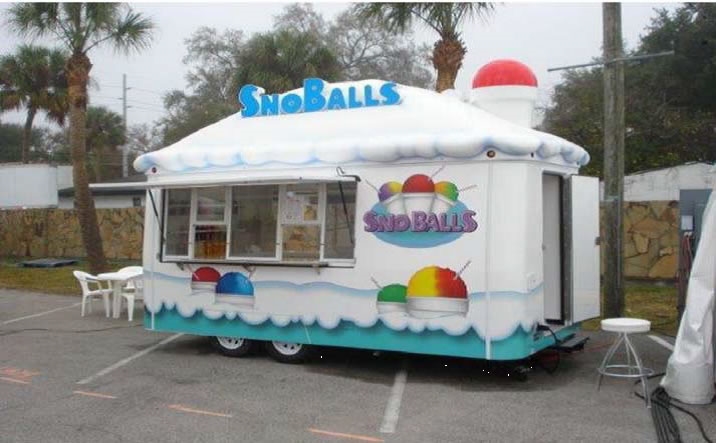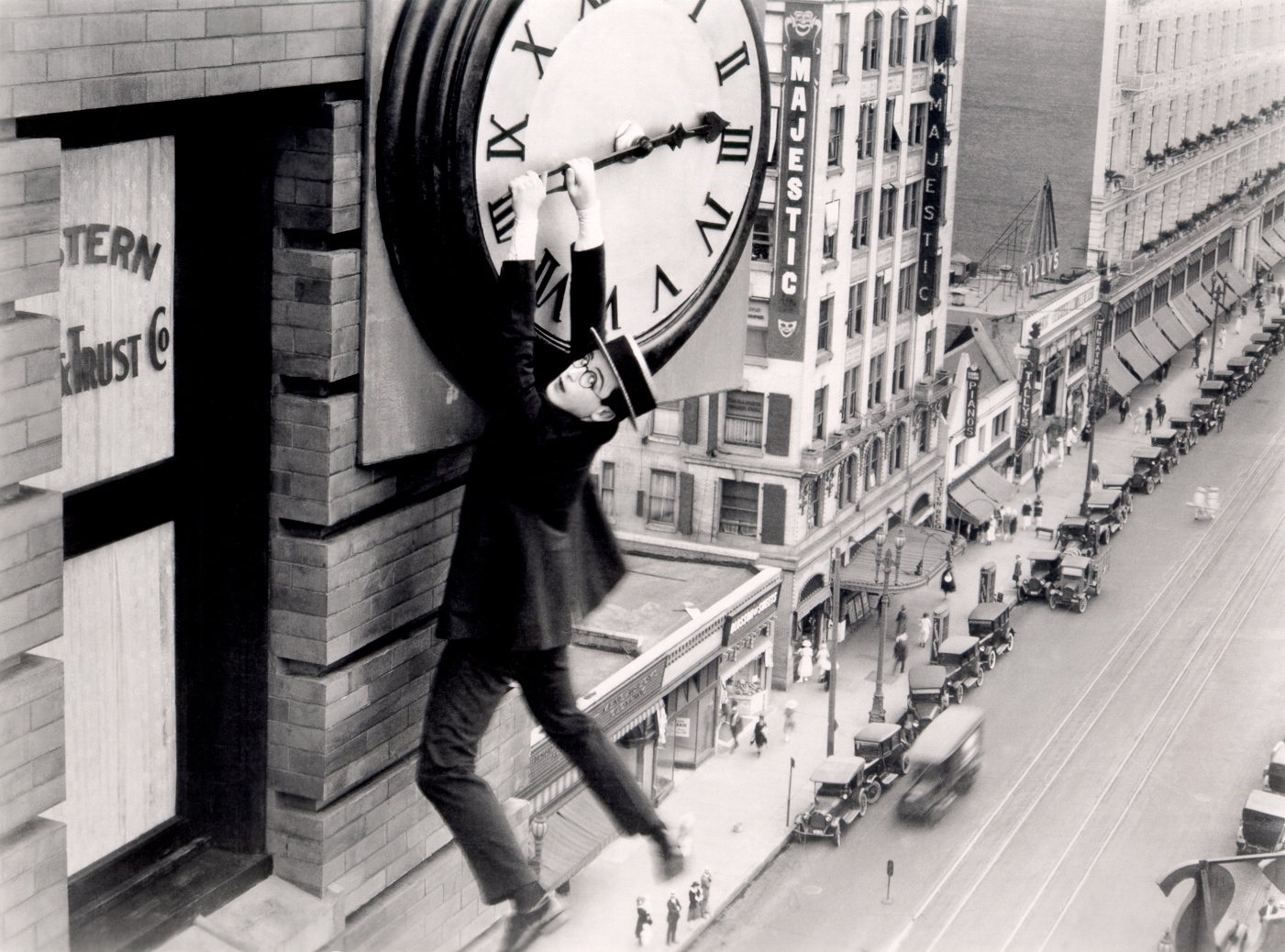TRADEMARK BOARD CHILLY TOWARD "SNOBALLS" PRODUCT DESIGN
Timothy J. Lockhart
In a recent trade dress case the U.S. Trademark Trial and Appeal Board (TTAB) ruled that the design of a "SNOBALLS" concession trailer lacked acquired distinctiveness and therefore was ineligible for registration on the Principal Register of the U.S. Patent and Trademark Office (USPTO). In re SnoWizard, Inc., 129 USPQ2d 1001 (TTAB 2018) [precedential] (Opinion by Judge George C. Pologeorgis).
SnoWizard, Inc. filed an application to register this image as a trademark for a "concession trailer for snowball vendors to operate a viable snowball business."

The applicant described the mark as consisting of "a three-dimensional configuration of a snow-capped roof with the word 'SNOBALLS', a snowball and associated beverage container positioned on top of a concession trailer for snowball vendors." SnoWizard disclaimed the exclusive right to use "SNOBALLS" apart from the mark as a whole, stated a first-use date of 2009, and claimed that the mark has acquired distinctiveness under Section 2(f) of the Trademark Act, 15 U.S.C. § 1052(f).
The USPTO Examining Attorney refused to register the mark, finding it was a non-distinctive product design that had not acquired distinctiveness, and the applicant appealed. As an initial matter the TTAB noted that because SnoWizard had claimed acquired distinctiveness under Section 2(f), the applicant had "effectively conceded" that the mark was not inherently distinctive (citation omitted). Nevertheless, because SnoWizard argued that its mark was product packaging, not product design, and therefore did not require a showing of acquired distinctiveness, the TTAB considered that issue.
The TTAB discussed the difference between product packaging, which can be inherently distinctive, and product design, which cannot be (citing Wal-Mart Stores Inc. v. Samara Bros., 529 U.S. 205 (2000) (other citation omitted). The TTAB said that "[p]roduct design consists of some or all of the design elements of the product itself such as its size, shape, coloring or color combinations, while product packaging consists of some or all of the elements of the packaging or labeling of a product" (citing Wal-Mart Stores at 210-11). Under that test the TTAB "fail[ed] to see how Applicant's asserted mark, composed of physical aspects of its concession trailers, constitutes product packaging, when the mark consists of the configuration of the roof of its products, the concession trailers, and the word SNOBALLS."
Noting that SnoWizard had at times characterized its mark as "trade dress" as opposed to product design, the TTAB said that trade dress has come to include such design. "While 'trade dress' historically has been more often used to refer only to the packaging and labeling of a product, the breadth of the term has been expanded to include the shape and design of a product itself (citing Elmer v. ICC Fabricating, 67 F.3d 1571 (Fed. Cir. 1995)) (trade dress refers to product packaging and the design of the product itself) (other citations omitted). Thus, SnoWizard's use of the term "trade dress" made no difference in the TTAB's analysis.
Because it found that SnoWizard's mark was product design, the TTAB proceeded to consider whether the applicant had provided sufficient evidence to prove that the mark had acquired distinctiveness. The TTAB said that "the evidence provided to establish acquired distinctiveness must relate to the promotion and recognition of the specific configuration embodied in the applied-for mark and not to the goods in general (citing Inwood Labs., Inc. at 844 n.11 ("[t]o establish secondary meaning, a manufacturer must show that, in the minds of the public, the primary significance of a product feature or term is to identify the source of the product rather than the product itself") (other citations omitted).
The TTAB laid out the six Converse factors for determining whether trade dress has acquired distinctiveness: (1) association of the trade dress with a particular source by actual purchasers (typically measured by customer surveys); (2) length, degree, and exclusivity of use; (3) amount and manner of advertising; (4) amount of sales and number of customers; (5) intentional copying; and (6) unsolicited media coverage of the product embodying the mark (citing Converse, Inc. v. Int'l Trade Comm'n, 909 F.3d 1110, 1120 (Fed. Cir. 2018)).
SnoWizard asserted that it had sold its concession trailers for nine years, grossing approximately $35,000 per year. However, the TTAB said it could not "glean any meaningful information from these sales figures since Applicant failed to submit any evidence regarding the cost of each of its concession trailers, how many consumers have purchased Applicant's concession trailers, or how many trailers it sold per year." The TTAB also said that "Applicant's alleged length of use of its asserted mark . . . is simply insufficient, in itself, to bestow acquired distinctiveness."
Instead, the TTAB said, "the critical inquiry is whether the applied-for product design is used and advertised in the marketplace in a manner that educates consumers to recognize the product design as serving to distinguish the source of such products from the goods of others" (citing Stuart Spector Designs Ltd. v. Fender Musical Instruments Corp., 94 USPQ2d 1549, 1572 (TTAB 2009) ("[t]o determine whether a configuration has acquired distinctiveness, advertisements must show promotion of the configuration as a trademark"). In that context the TTAB noted that "look for" advertising can be "particularly probative on the issue of whether a product design functions as a source identifier" and defined such advertising as marketing materials that direct "the potential consumer in no uncertain terms to look for a certain feature to know that it is from that source" (citing Stuart Spector Designs at 1572).
In this case the record was "devoid" of such advertising, the TTAB said. The website screenshot that the applicant submitted showed "a number of different trailers, only some of which contain the elements depicted in the drawing of the applied-for mark, and fewer of which contain all the elements depicted in the drawing of the asserted mark." Furthermore, the TTAB said, "there is nothing from the provided screen capture to show that Applicant is advertising the applied-for product design," and the Examining Attorney's opposing evidence showed that "concession trailers with decorative roofs consisting of representations of ice, snow cones, and similar food item designs are not uncommon."
In conclusion, the TTAB said that after weighing all of the relevant factors it found that SnoWizard had "not established that [Applicant's] non-inherently distinctive product design (or trade dress) . . . ha[d] acquired distinctiveness as a source identifier in connection with Applicant's snowball concession trailers."

U.S. COPYRIGHTED WORKS ENTER PUBLIC DOMAIN-FINALLY
Timothy J. Lockhart
On January 1, 2019, a large group of U.S. copyrighted works entered the public domain for the first time this century. In 1998 Congress extended copyright protection for another 20 years, meaning works first published in 1923 that would have entered the public domain on January 1, 1999, were subject to copyright protection for another two decades.
Before the Copyright Act of 1976, U.S. copyright protection lasted for an initial term of 28 years and an optional renewal term of another 28 years, meaning that previously works from as late as 1962 (for example, Rachel Carson's influential environmental book Silent Spring) would have entered the public domain on January 1, 2019. The 1976 act extended copyright protection to the life of the author plus 50 years or to 75 years for a work of corporate authorship. The act also increased from 28 years to 47 years the extension term for works copyrighted before 1978 that had not already entered the public domain, giving such works a total protection term of 75 years.
The Copyright Term Extension Act of 1998 (CTEA) further extended copyright protection to 70 years after an author's death or, for works created by corporate "authors" under the work-made-for-hire doctrine, for 95 years from the year of first publication or 120 years from the year of creation, whichever expires first. The act also extended protection for works published before January 1, 1978, by 20 years to a total of 95 years from their publication date. The CTEA was also known as the Sonny Bono Act (to honor the late U.S. representative who had sponsored similar legislation) or, jokingly, the "Mickey Mouse Protection Act" (because Congress allegedly acted at the behest of the U.S. movie industry).
The works from 1923 that are now in the public domain include these movies:
- Cecil B. DeMille's silent version of The Ten Commandments;
- Harold Lloyd's comedy Safety Last!, including the famous scene where he dangles from a clock;
- Charlie Chaplin's The Pilgrim, Buster Keaton's Our Hospitality, and Our Gang (later titled Little Rascals); and
- The debut films of Marlene Dietrich, Douglas Fairbanks Jr., and Fay Wray (later of King Kong fame).
The 1923 works also include literature:
- The Prophet by Kahlil Gibran;
- The Murder of Roger Ackroyd and The Murder on the Links, two of Agatha Christie's Hercule Poirot novels;
- Short stories by Virginia Woolf, Katherine Mansfield, and Ernest Hemingway; and
- Poetry by Edna St. Vincent Millay, E.E. Cummings, William Carlos Williams, Rainer Maria Rilke, Wallace Stevens, and Robert Frost.
In addition, the 1923 works include music such as:
- "Who's Sorry Now?";
- "Tin Roof Blues";
- "That Old Gang of Mine";
- "Yes! We Have No Bananas"; and
- "The Charleston" (a big factor in the popularity of the Charleston dance that it was written to accompany).
Unless Congress extends copyright protection again (which at present seems unlikely), all U.S. works from the 1920s will enter the public domain by 2025. Such works include Steamboat Willie, the 1928 film that introduced the world to, yes, Mickey Mouse.


